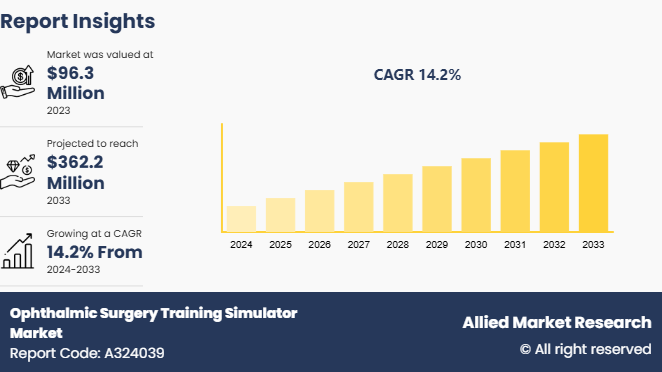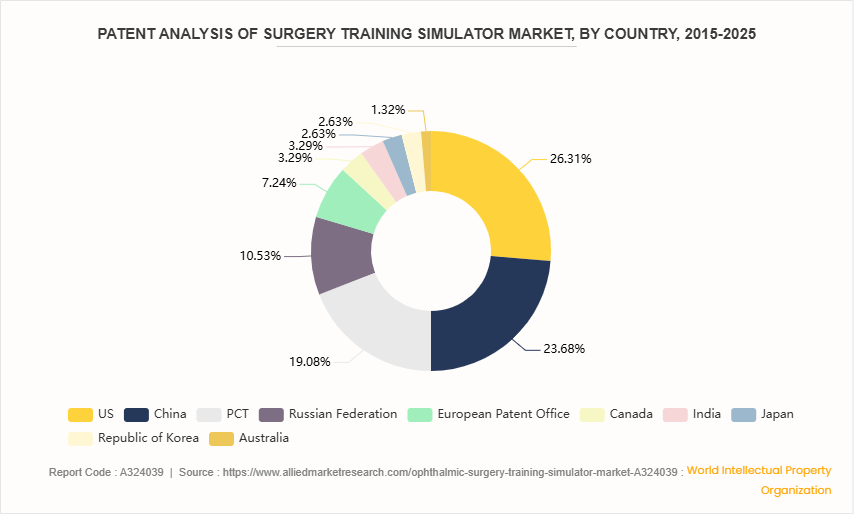Ophthalmic Surgery Training Simulator Market Research, 2033
The global ophthalmic surgery training simulator market size was valued at $96.3 million in 2023, and is projected to reach $362.2 million by 2033, growing at a CAGR of 14.2% from 2024 to 2033. The ophthalmic surgery training simulator market is driven by the increasing demand for advanced surgical training tools, which enhance precision and reduce the risk of human error. Additionally, the growing adoption of minimally invasive surgeries and technological advancements in simulation technology are further fueling ophthalmic surgery training simulator market growth.

Market Introduction and Definition
An ophthalmic surgery training simulator is a sophisticated device or software platform designed to replicate the environment and procedures involved in ophthalmic surgery, allowing medical professionals to practice and refine their skills in a controlled, risk-free setting. These simulators use advanced technologies such as virtual reality (VR) , augmented reality (AR) , or haptic feedback to provide realistic and immersive surgical experiences. They offer a variety of training modules that simulate different ophthalmic procedures, such as cataract surgery, retinal surgeries, and corneal transplantations. By replicating real-life challenges, these simulators help surgeons improve their dexterity, decision-making, and procedural techniques, while also enhancing their ability to manage complications. Ophthalmic surgery training simulators are increasingly being integrated into medical curricula, continuing education programs, and professional certification processes to ensure that practitioners maintain high levels of competence in performing delicate eye surgeries.
Key Takeaways
- The ophthalmic surgery training simulator market study covers 20 countries. The research includes a segment analysis of each country in terms of value ($Million) for the projected period 2023-2033.
- More than 1, 500 product literatures, industry releases, annual reports, and other such documents of major ophthalmic surgery training simulator industry participants along with authentic industry journals, trade associations' releases, and government websites have been reviewed for generating high-value industry insights.
- The study integrated high-quality data, professional opinions and analysis, and critical independent perspectives. The research approach is intended to provide a balanced view of global markets and to assist stakeholders in making educated decisions in order to achieve their most ambitious growth objectives.
Key Market Dynamics
The ophthalmic surgery training simulator market size is driven by several key factors. First, the increasing demand for advanced surgical training due to the rising prevalence of eye disorders and the need for more specialized surgical skills is a major driver for ophthalmic surgery training simulator market growth. The growing adoption of simulation-based education across medical institutions is also contributing to the market's growth, as these simulators provide realistic, hands-on experience without the risks associated with live surgeries. Additionally, technological advancements in virtual reality (VR) and augmented reality (AR) are enhancing the effectiveness of ophthalmic surgery simulators, making them more attractive to training centers.
However, the market faces certain restraints, including the high cost of advanced ophthalmic surgery simulators, which can limit their adoption, particularly in developing countries. Furthermore, the lack of skilled professionals to operate these high-tech systems and the initial investment required for setting up simulation centers can pose challenges for institutions with limited budgets. There is also a need for standardization in training programs, as the variability in simulation platforms and training protocols can affect the consistency of outcomes.?
Market Segmentation
The ophthalmic surgery training simulator industry is segmented into product type, surgery type, end-user, and region. On the basis of product type, the market is classified into virtual reality (VR) /augmented reality (AR) -based simulators, hybrid simulators, basic simulators, and others Based on surgery type, the market is categorized into cataract surgery, vitreoretinal surgery, glaucoma surgery and others. As per end user, the market is divided into hospitals, ophthalmic clinics, academic & research institutes, and others. Region wise, the market is analyzed across North America, Europe, Asia-Pacific, and LAMEA.
Regional/Country Market Outlook
North America holds the largest ophthalmic surgery training simulator market share due to several key factors. One of the primary reasons is the well-established healthcare infrastructure in the region, which supports the adoption of advanced medical technologies, including ophthalmic surgery simulators. The presence of leading medical institutions, universities, and training centers that prioritize cutting-edge education and training further drives the demand for these simulators.
Additionally, North America has a high concentration of skilled ophthalmic surgeons and a strong focus on improving surgical outcomes, which enhances the need for advanced simulation technologies that offer safe, effective, and realistic training environments. The region also benefits from substantial healthcare funding, including investments from both private and public sectors, facilitating the acquisition of high-tech simulation equipment. Furthermore, the increasing prevalence of eye diseases in North America, coupled with the growing demand for specialized surgical skills, contributes to the market's growth. The integration of virtual reality (VR) and augmented reality (AR) technologies in training simulators is also more prevalent in North America, further drive growth during ophthalmic surgery training simulator market forecast.
Industry Trends
- The development of high-fidelity simulators with virtual reality (VR) , augmented reality (AR) , and artificial intelligence (AI) is enhancing training experiences. These technologies allow for more interactive and realistic simulations of ophthalmic procedures, such as cataract surgery, vitrectomy, and refractive surgeries.
- As the number of ophthalmic surgeries increases globally, there is a greater focus on improving surgical skills and reducing human errors. Simulators provide a safe and controlled environment for training, improving both novice and experienced surgeons' capabilities.
Patent Analysis, By Country, 2015-2024
U.S. witnessed the highest number of patent approvals and applications, due to favorable government policies, new technological advancement and new service and software launches in the country. China has 23.68% of the total number of patents, followed by PCT at 19.08%.

Competitive Landscape
The major ophthalmic surgery training simulator market share players operating in the ophthalmic surgery training simulator market include Alcon, Eyesi Surgical, Haag-Streit, Simulab Corporation, CAE Healthcare, Virtamed, Surgical Science, VRmagic, Medtronic and KARL STORZ.
Key Benefits For Stakeholders
- This report provides a quantitative analysis of the ophthalmic surgery training simulator market segments, current trends, estimations, and dynamics of the ophthalmic surgery training simulator market analysis from 2023 to 2033 to identify the prevailing ophthalmic surgery training simulator market opportunity.
- The market research is offered along with information related to key drivers, restraints, and opportunities.
- Porter's five forces analysis highlights the potency of buyers and suppliers to enable stakeholders make profit-oriented business decisions and strengthen their supplier-buyer network.
- In-depth analysis of the ophthalmic surgery training simulator market segmentation assists to determine the prevailing market opportunities.
- Major countries in each region are mapped according to their revenue contribution to the global ophthalmic surgery training simulator market statistics.
- Market player positioning facilitates benchmarking and provides a clear understanding of the present position of the market players.
- The report includes the analysis of the regional as well as global ophthalmic surgery training simulator market trends, key players, market segments, application areas, and market growth strategies.
Key Sources Referred
- Centers for Disease Control and Prevention
- World Health Organization
- National Center for Biotechnology Information
- The Lancet
- National Perinatal Epidemiology and Statistics Unit (NPESU)
- Science Direct
- Health Resources and Services Administration (HRSA)
- Department of Health and Human Services (HHS)
- National Institutes of Health (NIH)
Ophthalmic Surgery Training Simulator Market Report Highlights
| Aspects | Details |
| Market Size By 2033 | USD 362.2 Million |
| Growth Rate | CAGR of 14.2% |
| Forecast period | 2024 - 2033 |
| Report Pages | 260 |
| By Product Type |
|
| By Surgery Type |
|
| By End User |
|
| By Region |
|
| Key Market Players | Medtronic, Eyesi Surgical, KARL STORZ?, Surgical Science, CAE Healthcare Inc., VirtaMed AG, Haag-Streit, Alcon, vrmagic, Simulab Corporation. |
The top companies holding market share in the ophthalmic surgery training simulator market include CAE Healthcare, VirtaMed, and Simbionix, known for their advanced simulation technologies used in ophthalmic surgical training.
The ophthalmic surgery training simulator market was valued at $96.3 million in 2023 and is estimated to reach $362.2 million by 2033, exhibiting a CAGR of 14.2% from 2024 to 2033.
The largest regional market for ophthalmic surgery training simulators is North America, driven by advanced healthcare infrastructure, high adoption of innovative technologies, and strong demand for ophthalmic training.
The leading application of the Ophthalmic Surgery Training Simulator Market is in training medical professionals for cataract surgeries, enabling skill development and precision before performing actual procedures.
The global Ophthalmic Surgery Training Simulator Market is witnessing trends like the integration of VR and AR technologies for immersive training, increasing adoption in academic and clinical settings, and a focus on AI-driven personalized skill assessment.
Loading Table Of Content...


